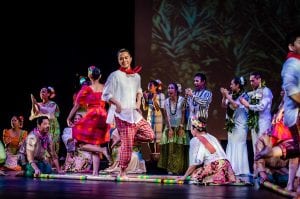The Tinikling (bamboo dance) is a widely recognized traditional folk dance of the Philippines. It’s said that during colonization, natives who worked too slowly in the plantations would be punished by having their feet beaten by bamboo. Natives would jump to avoid being struck and in doing so, their movements seem to imitate the long-legged Tikling Philippine bird that quickly yet gracefully escapes rice field traps set by farmers. It’s danced to an ensemble of stringed instruments or rondalla music which is heavily influenced by past Spanish rule. In its simplest form, the dance involves two people (clappers) hitting, sliding, clapping 12 ft. long bamboo poles on the ground and against each other in synchronization. Simultaneously the dancer(s) step between and over the bamboo. More complex forms of the dance include 4 or more poles in cross formations and 4 or more clappers and dancers. Both women and men wear traditional dresses and outfits and must be barefoot. It takes practice, agility, coordination, and rhythm to keep from getting your ankles caught as the tempo speeds up and bamboo formations change. The dance is usually done during town/national festivals, wedding receptions, other special occasions. Tinikling is one of many folk dances that pay tribute to our history by retelling a story. It is a dance that embodies the spirit of the people, by turning adversities into a beautiful and skillful art form.
Here are example videos, each with their own unique style of choreography:
